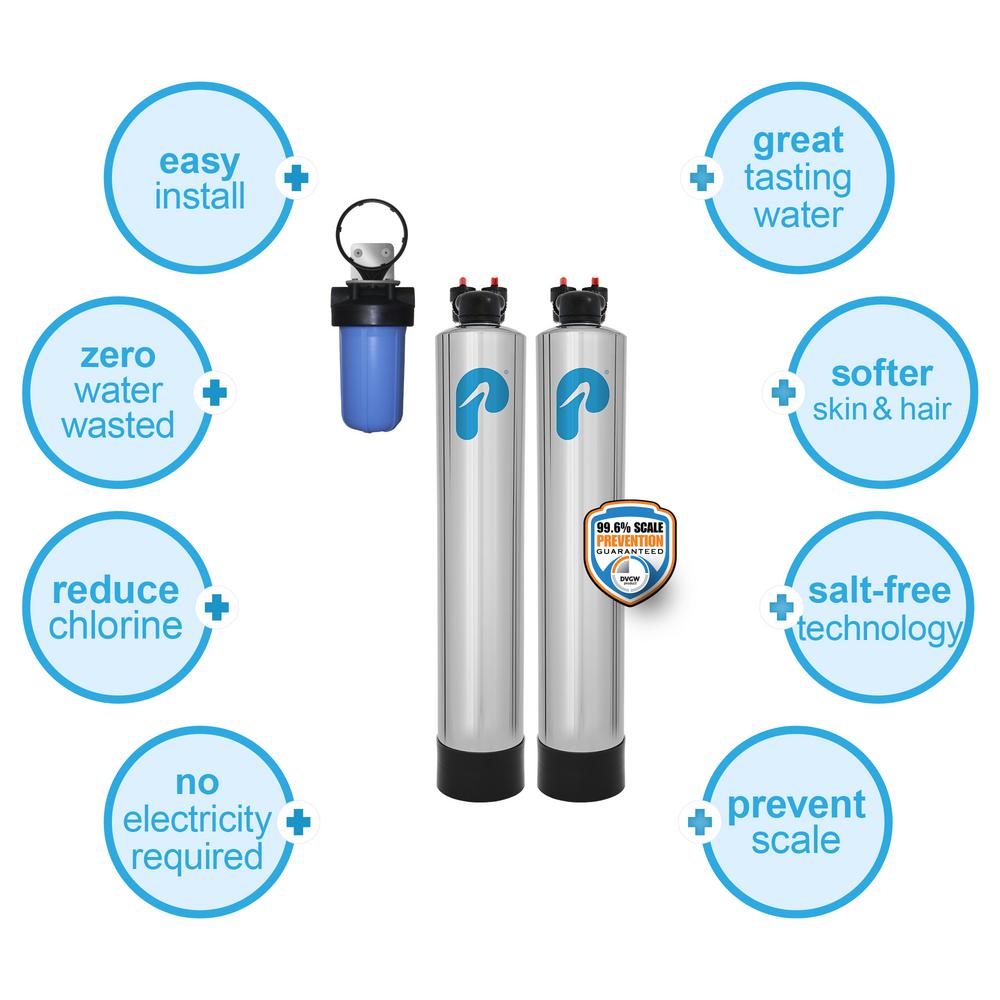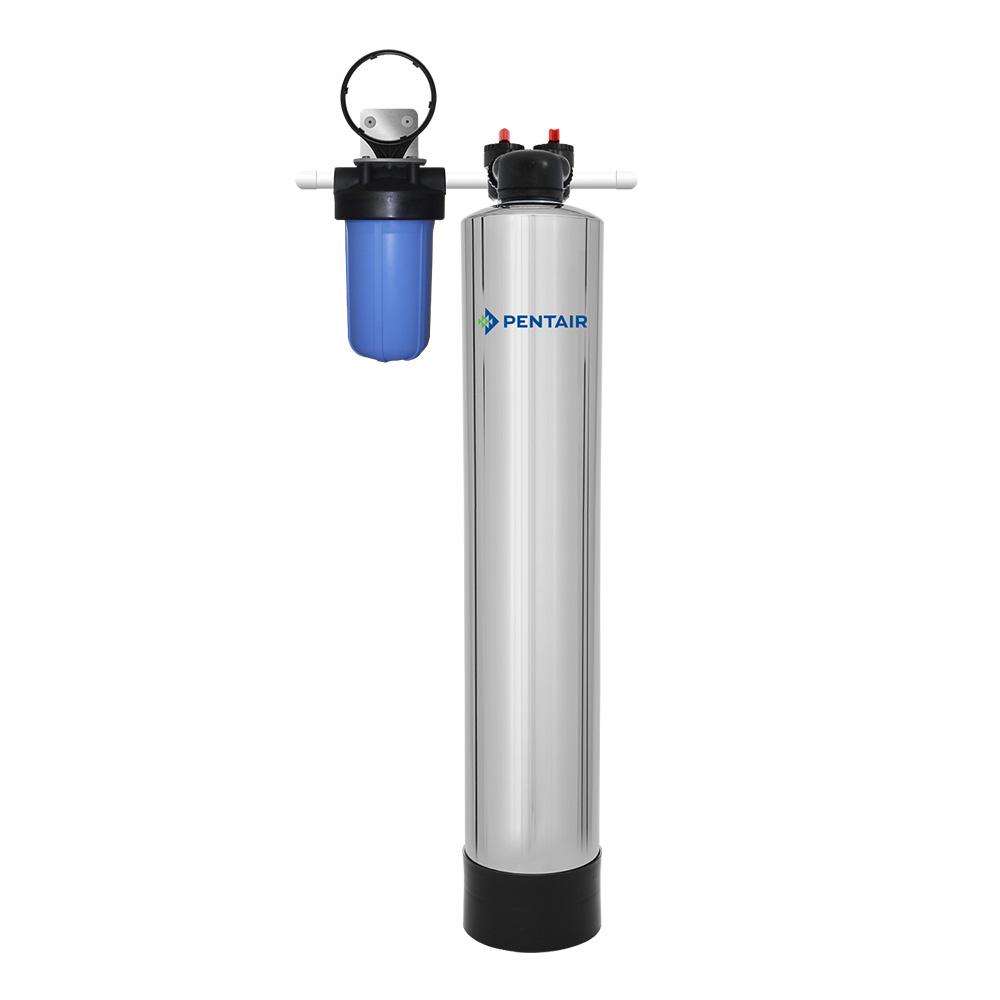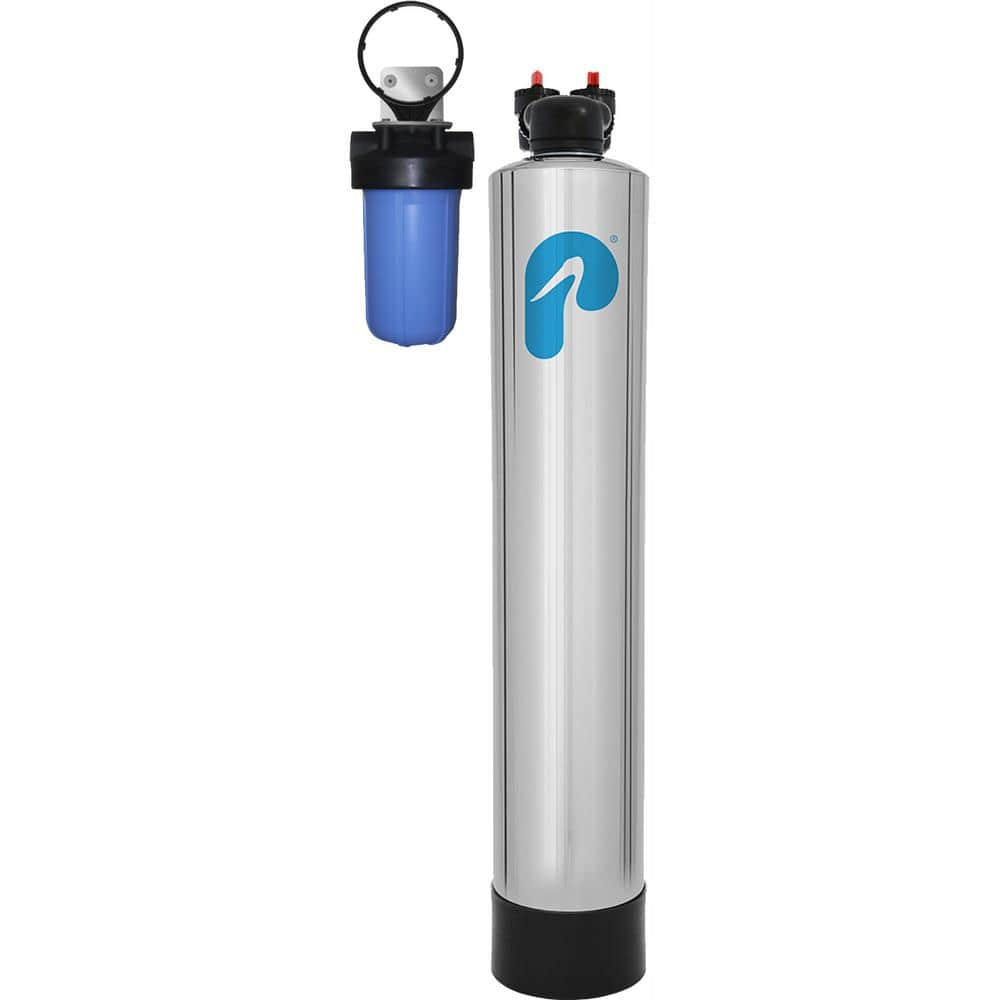Pelican Water 10 GPM Whole House Water Filtration and NaturSoft Water Softener Alternative System
Whole-house water filtration (chlorine and chemicals). Water softening alternative: 99.6% certified scale prevention. No salt, no electricity, no wasted water.
Filtered and softened water from every tap with the Pelican PSE1800 Whole House Water Filtration and NaturSoft Water Softener Alternative System. This system combines the benefits of the whole house carbon water filter along with the NaturSoft water softener alternative to give you better than bottled water quality. Start enjoying great tasting water and softer skin and hair, all while stopping the negative effects of hard water scale build-up without the use of salt, potassium or harsh chemicals. Additionally, the Pelican combo system is low maintenance and does not require a drain, wastes no water and does not use electricity. Pelican Water Systems provides the new standard in home filtration and water treatment products.
- Whole home solution addresses sediment, chemicals, chlorine and chloramine, hardness and scale
- Reduces scale 99.6%, only DVGW certified water softener alternative in North America
- Handles hard water scale in plumbing and appliances, extending their life
- Filtered and treats water from every tap, kitchens, bathrooms, laundry and more
- Includes sediment pre-filter system with mounting hardware
- Bacterial static media inhibits bacterial growth
- Energy efficient; does not waste water and requires no electricity
- Wrapped in premium stainless steel to ensure long life, durability and unsurpassed quality
- Pelican carbon filter and NaturSoft system is preloaded, ready to install, minimizing steps and saving time
- NaturSoft water softener alternative lifetime guarantee, no media replacement necessary
- Sediment pre-filter requires minimum replacement every 6 to 9 months; carbon filtration media every 5 years or 600,000 Gal.
- Approved for use in water districts that ban or restrict use of salt based softeners
- 10 GPM ideal for homes with 1 to 3 bathrooms based on flow demand of 3.3 GPM, per bathroom running at the same time
- Pelican Water systems PSE1800 contains a PC600 system that is Certified by IAPMO R&T to NSF/ANSI standard 42 for the reduction of chlorine up to 97%, structural integrity and NSF/ANSI 61 for material safety; PSE1800 contains a Pelican NS3 system that is Certified by IAPMO R&T to NSF/ANSI Standard 42 structural integrity and NSF/ANSI 61 for material safety
- Certifications: NSF/ANSI 42, NSF/ANSI 61
Additional information
| Fitting size (in.) | 1 |
|---|---|
| Product Depth x Height x Width (in.) | 18 x 49.5 x 27 |
| Certifications and Listings | IAPMO Certified |
| Manufacturer Warranty | Limited Lifetime Warranty |




by Mike
The install video was a huge help for the plumber. He had no problem installing the system. It talks up even less room than I expected. So far, our water tastes and smells much better.
by Naples
Best choice for whole house filtration and softer water. We recently had three bathrooms updated and wanted to minimize any damage to the new fixtures. The old ones were corroded and crusted with a hard coating of crud. Installation was relatively easy especially after watching the installation videos and getting technical assistance from tech rep, Anthony.
by Tommy
It’s great not to add salt every couple of weeks./ The water tastes great… I installed the unit my myself, it only took a couple of hours.
by Kirk
Installed easily. Our water quality (taste) greatly improved and we now longer can taste the chlorine and chemicals that were there before. The softener has changed how the water feels as we shower and are waiting to see how the technology of leaving in the good minerals will affect our appliances and plumbing overall. Very satisfied with the product so far.
by Andy
Bought the PSE1800, wanting a more complete system. Within a couple hours and days we noticed the taste and odors of the water were dramatically improved. I bought the additional quick install kit. After having to find cpvc 1 inch piping (not and easy task) and getting a couple of quotes of 500 dollars to install, my cost total cost was about 250 dollars and about 2 hrs of my time. Plan to enjoy this system for a very long time.
by Deepsea
Cool clear water and it tastes great. So far so good. The system is fantastic and I piggybacked it with a new tankless water heater. What a difference. We’ll see how it goes five years down the road when I have to replace canisters.
by Nancy
For 25 years living in Yuma, AZ using a water softener we have had to replace our electric water heater six times, and our water softener once because the resin tank beads broke apart and blocked all of our copper plumbing in the house. We replaced it with the Kinetico Premium system and this year they have had to replace the resin tanks three times because of leaks, and the control head required a part so that it could regenerate again. We have a GE GeoSpring heat pump water heater and after eight years it started to leak, this was using the Kinetico water softener with Morton’s salt. After extensive research and reading articles about the TAC (template assisted crystallization) system we chose the Pelican PSE 1800. Also because of an extensive study by ASU (University of Arizona in 2011) about the TAC system and using water from the Salt River (Tempe water), (CAP), and Scottsdale the TAC system out performed all other alternatives. The Pelican whole house system is by far the best one on the market, with their warranty, and the fact that it can handle hardness up to 75 grains and is part of Pentair a leader in water quality products. Also, our water company was in violation of TTHMs, and the carbon whole house tank will get rid of these by-products. We do not miss the slimy feeling that the Kinetico softener makes the water feel, and even with this softener we still had water spots to contend with. No more buying salt, no more brine water going into our septic system in our yard. The Pelican water in the shower feels great giving us lots of lather, and rinses clean, we can now drink from every faucet in the house, and we can see that the shower head flow is much better, less scale. We always wipe down the tile shower and glass door and so any spots left by the Pelican system will not be there. As a senior, and a woman, I installed the system myself after letting the carbon tank soak for 48 hours and flushing it out. The total time for the installation was two hours and 30 minutes. We are happy with our unit and have recommended it to our friends who live in the same area and have told them the benefit’s of this type of system.
by Paolo
This system was installed four years ago and has performed as desired. It has worked great and is completely self attending, no electricity, no chemicals and no maintenance other than changing the sediment filter. No, it is not a water softener but it does what it is supposed to do. And it does not create that “slippery feeling” that comes from chemical water softeners. It does this without the expense of salt, wasted flushing water and is better for the environment. Many communities have outlawed salt type systems due to environmental considerations. We have had no salt deposits anywhere in house since installing this Pelican system. Water tastes great. Shower glass and fixtures stay sparkling. Have had the system for four years and four months. We change sediment filter only once a year. Then still looks fairly clean. Have irrigation outside before system so expect system to last ten years before changing carbon. Note recommend using SharkBite fittings for a custom installation. They really work great! They are worth the cost! One caution. The system is not going to work for extremely hard water, according to my previous research. We have fairly hard water, it is around a number 9 as I recall. So if you have extremely hard water or extremely smelly water with iron or sulfur, best to get a thorough analysis and professional recommendation so you won’t be disappointed in results. Bottom line, this system will deliver great results at a price that cannot be beat. Granted professional installation will increase the cost but still the best solution in my opinion.
by Baylie
The filters are really great! Top notch quality and great instructions. Very good sales as well as technical support for the one call I had during installation. After installing everything and turning the water on, three o-rings leaked (2 slightly, 1 a lot). Turns out that when putting them in, they pinched a bit. The tech support gave great advice on how to remove and put new o-rings if needed. I also put a little silicon grease on the o-rings to ensure they didn’t catch/pinch again. Perfect fit 2nd time around. Best is water now tastes GREAT and also the hardness of the water is non-existent! Everyone is happy! I’m recommending this product to all my friends!
by Fred
3 year resident of AZ, having moved from IA. My previous experience with a water softener system, was a purchase in 1996 from Kinetico. When I as 26, I didn’t mind lugging salt from the store to the car, to the salt tank. Today, at 50, carrying salt is not something that I see doing any further down the road. AZ water is hard, very hard. So hard, that within 2 years of our new home being built, the water had begun to etch the glass shower panels in our home. I was able to remove the damage, but the steps taken to remove that mess, are what fueled me to order the Pelican Whole House filter / softener combo. I opted for the PSE2000 for flow rate, since we have 5 bedrooms, however 3 are full time occupied. I had been researching this product for about 18 months. What kept bringing me back to Pelican, were the attractions of; ordering online (I don’t have to sit through a water test in my home), 99.6% effective certification, no salt!, no electricity, no discharge / no drain, no mess, low cost (investment and use), and most importantly – self install. Now, I’m not a plumber. Our house was built with a soft water loop in the garage. I had been eyeing that thing for 3 years, thinking ‘that looks pretty easy to hook into, I just need a system that I can install myself.’ Ironically, that was the part of the install that gave me the most hassle. Why? The first thing I would do next time is start with local code for water delivery within the dwelling. The first run at installing the plumbing prior to the pre-filter, was using PVC. I like PVC, always enjoyed working with it. What I didn’t factor in for this install, was that it’s 109 degrees outside and the humidity is around 11%. The time you have to produce a connection (prime, glue, connect) is about 10 seconds. I don’t like to move that fast anymore. So my first 3-valve bypass attempt, using PVC created a leak in one of the 14 connections I made. I cut it out, started over. PVC is inexpensive. The second attempt went much better, but again – 1 leak. Feeling defeated, I called a plumber to come give me a quote for installing the bypass valves and shut off valve prior to the pre-filter. He couldn’t get to me until the following week. He did inform me though, that PVC was not code for water delivery, in my area. He was going to use copper. Meh, ok, I don’t want the look (or expense), but I just want it working. Called a second plumber, who said he was going to use PEX. I asked if that was compliant with code, he said it was. Then he sent me the code, so I could see for myself (nice touch). He quoted me two prices, one shut off valve prior to pre-filter, and one with 3 way bypass and one shut off. 1 valve – reasonable, 4 valves … the price seemed too high. So I started researching PEX, prices, availability, how to work with it. PEX, was exactly what I needed. Cut the second PVC attempt out, started with the PEX, and in less than an hour, I had the water back on in the house (minus PSE2000). From there, life was simple. Figuring out where I wanted the pre-filter, routing of the home install kit johns guest lines, the return to the house, etc. So how does it work? The first thing I noticed, while taking a shower, was the soap I had in my washrag, lasted the entire shower. In fact, I had to rinse the soap out of the rag. This was different than the previous day, where I had to add more soap to the rag during the shower. Next time, less soap. Also, no slimy feeling. I don’t mind ‘slimy’, I know its soft water (competitor), but my family is not a fan of slimy feeling water. The PSE2000 does not produce this type of soft water. After the shower, my skin felt better. Before, we had to apply skin lotion upon exit from shower. Last night, not needed. The combination of previous hard water, the low humidity state in AZ … tough combo on skin. I think we’ve fixed that. I typically don’t like to review this early (day after install), but given the few weeks upcoming, it had to be done. First impressions point me to recommend this system to anyone. Again, low cost, no salt, desired results, self install, online order without speaking to anyone, solid shipping … it’s all great! If you are not a plumber, and have the lines ready up to the pre-filter … using the home install kit is an absolute snap. Connecting what Pelican sent me, took less than 30 minutes. If you want a water softener that is inexpensive, produces results, is easy to connect, uses no salt, produces no drainage, this is it. Everything worked as described in the instructions (READ them all, even the notes). This is well designed, and made simple install. The finished product looks great, and is all self contained.